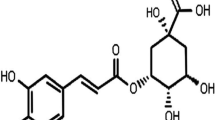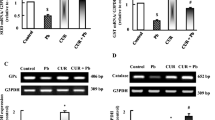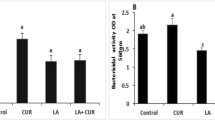Abstract
This study aims to evaluate the protective role of curcumin (Curc) against hematological and biochemical changes, as well as renal pathologies induced by lead acetate [Pb (CH3COO)2·3H2O] treatment. Male albino rats were intraperitoneally treated with Pb2+ (25 mg of lead acetate/kg b.w., once a day) alone or in combination with Curc (30 mg of Curc/kg b.w., twice a day) for 7 days. Exposure of rats to Pb2+ caused significant decreases in hemoglobin (Hb) content, hematocrit (Ht) value, and platelet (Plt) count, while Pb2+-related leukocytosis was accompanied by absolute neutrophilia, monocytosis, lymphopenia, and eosinopenia. A significant rise in lipid peroxidation (LPO) and a marked drop of total antioxidant capacity (TAC) were evident in the kidney, liver, and serum of Pb2+ group compared to that of control. Furthermore, significantly high levels of total cholesterol (TC), triglycerides (TGs), and low-density lipoprotein cholesterol (LDL-C), and a sharp drop in serum high-density lipoprotein (HDL-C) level were also seen in blood after injection of Pb2+. Additionally, hepatorenal function tests were enhanced. Meanwhile, Pb2+ produced marked histo-cytological alterations in the renal cortex. Co-administration of Curc to the Pb2+-treated animals restored most of the parameters mentioned above to near-normal levels/features. In conclusion, Curc appeared to be a promising agent for protection against Pb2+-induced toxicity.






Similar content being viewed by others
References
Mañay N, Cousillas AZ, Alvarez C, Heller T (2008) Lead contamination in Uruguay: the “La Teja” neighborhood case. Rev Environ Contam Toxicol 195:93–115
Alebiosu CO (2003) An update on “progression promoters” in renal diseases. J Natl Med Assoc 95:30–42
Herman DS, Geraldine M, Venkatesh T (2007) Evaluation, diagnosis, and treatment of lead poisoning in a patient with occupational lead exposure: a case presentation. J Occup Med Toxicol 2:7
Patrick L (2006) Lead toxicity, a review of the literature. Part 1: exposure, evaluation, and treatment. Altern Med Rev 11:2–22
Berrahal AA, Lasram M, El Elj N, Kerkeni A, Gharbi N, El-Fazâa S (2011) Effect of age-dependent exposure to lead on hepatotoxicity and nephrotoxicity in male rats. Environ Toxicol 26:68–78
Ercal N, Gurer-Orhan H, Aykin-Burns N (2001) Toxic metals and oxidative stress part I: mechanisms involved in metal-induced oxidative damage. Curr Top Med Chem 1:529–539
Bolin CM, Basha R, Cox D, Zawia NH, Maloney B, Lahiri DK, Cardozo-Pelaez F (2006) Exposure to lead and the developmental origin of oxidative DNA damage in the aging brain. FASEB J 20:788–790
Sharma V, Sharma A, Kansal L (2010) The effect of oral administration of Allium sativum extracts on lead nitrate induced toxicity in male mice. Food Chem Toxicol 48:928–936
Anamika B (2012) Extraction of curcumin. J Environ Sci Toxicol Food Technol 1:1–16
Strimpakos AS, Sharma RA (2008) Curcumin: preventive and therapeutic properties in laboratory studies and clinical trials. Antioxid Redox Signal 10:511–545
Venkatesan N, Punithavathi D, Arumugam V (2000) Curcumin prevents adriamycin nephrotoxicity in rats. Br J Pharmacol 129:231–234
Kuhad A, Pilkhwal S, Sharma S, Tirkey N, Chopra K (2007) Effect of curcumin on inflammation and oxidative stress in cisplatin-induced experimental nephrotoxicity. J Agric Food Chem 55:10150–10155
Cekmen M, Ilbey YO, Ozbek E, Simsek A, Somay A, Ersoz C (2009) Curcumin prevents oxidative renal damage induced by acetaminophen in rats. Food Chem Toxicol 47:1480–1484
Abdel Fattah EA, Hashem HE, Ahmed FA, Ghallab MA, Varga I, Polak S (2010) Prophylactic role of curcumin against cyclosporine-induced nephrotoxicity: histological and immunohistological study. Gen Physiol Biophys 29:85–94
Nabavi SF, Moghaddam AH, Eslami S, Nabavi SM (2012) Protective effects of curcumin against sodium fluoride-induced toxicity in rat kidneys. Biol Trace Elem Res 145:369–374
Trujillo J, Chirino YI, Molina-Jijón E, Andérica-Romero AC, Tapia E, Pedraza-Chaverrí J (2013) Renoprotective effect of the antioxidant curcumin: recent findings. Redox Biol 1:448–456
Ghoniem MH, El-Sharkawy NI, Hussein MMA, Moustafa GG (2012) Efficacy of curcumin on lead induced nephrotoxicity in female albino rats. J Am Sci 8:502–510
Daniel S, Limson JL, Dairam A, Watkins GM, Daya S (2004) Through metal binding, curcumin protects against lead- and cadmium-induced lipid peroxidation in rat brain homogenates and against lead-induced tissue damage in rat brain. J Inorg Biochem 98:266–275
Babalola OO, Okonji RE, Atoyebi JO, Sennuga TF, Raimi MM, Ejim-Eze EE, Adeniran OA, Akinsiku OT, Areola JO, John OO, Odebunmi SO (2009) Distribution of lead in selected organs and tissues of albino rats exposed to acute lead toxicity. Sci Res Essay 5:845–848
Schalms OW, Jain WC, Carrol EJ (1995) Veterinary haematology. Lea and Febiger, London
Janero DR (1990) Malondialdehyde and thiobarbituric acid-reactivity as diagnostic indices of lipid peroxidation and peroxidative tissue injury. Free Radic Biol Med 9:515–540
Koracevic D, Koracevic G, Djordjevic V, Andrejevic S, Cosic V (2001) Method for the measurement of antioxidant activity in human fluids. J Clin Pathol 54:356–361
Lowry OH, Rosebrough NJ, Farr AL, Randall RJ (1951) Protein measurement with the Folin phenol reagent. J Biol Chem 193:265–275
Schettler G, Nussel E (1975) Maınahmen zur Prävention der Arteriosklerose. Arb Med Soz Med Prav Med 10:25
Gordon T, Castelli WP, Hjortland MC, Kannel WB, Dawber TR (1977) High density lipoprotein as a protective factor against coronary heart disease. The Framingham Study. Am J Med 62:707–714
Friedewald WT, Levy RI, Fredrickson DS (1972) Estimation of the concentration of low-density lipoprotein cholesterol in plasma, without use of the preparative ultracentrifuge. Clin Chem 18:499–502
Sumanont Y, Murakami Y, Tohda M, Vajragupta O, Matsumoto K, Watanabe H (2004) Evaluation of the nitric oxide radical scavenging activity of manganese complexes of curcumin and its derivative. Biol Pharm Bull 27:170–173
John VD, Krishnankutty K (2005) Synthesis, characterization and antitumour activities of some synthetic curcuminoid analogues and their copper complexes. Transit Met Chem 30:229–233
Benassi R, Ferrari E, Grandi R, Lazzari S, Saladini M (2007) Synthesis and characterization of new beta-diketo derivatives with iron chelating ability. J Inorg Biochem 101:203–213
Jaruga E, Salvioli S, Dobrucki J, Chrul S, Bandorowicz-Pikuła J, Sikora E, Franceschi C, Cossarizza A, Bartosz G (1998) Apoptosis-like, reversible changes in plasma membrane asymmetry and permeability, and transient modifications in mitochondrial membrane potential induced by curcumin in rat thymocytes. FEBS Lett 433:287–293
Othman AI, Al Sharawy S, El-Missiry MA (2004) Role of melatonin in ameliorating lead induced haematotoxicity. Pharmacol Res 50:301–307
Romero D, Hernández-García A, Tagliati CA, Martínez-López E, García-Fernández AJ (2009) Cadmium- and lead-induced apoptosis in mallard erythrocytes (Anas platyrhynchos). Ecotoxicol Environ Saf 72:37–44
Apostoli P, Romeo L, De Matteis MC, Menegazzi M, Faggionato G, Vettore L (1988) Effects of lead on red blood cell membrane proteins. Int Arch Occup Environ Health 61:71–75
Scinicariello F, Murray HE, Moffett DB, Abadin HG, Sexton MJ, Fowler BA (2007) Lead and delta-aminolevulinic acid dehydratase polymorphism: where does it lead? A meta-analysis. Environ Health Perspect 115:35–41
Gurer H, Ercal N (2000) Can antioxidants be beneficial in the treatment of lead poisoning? Free Radic Biol Med 29:927–945
Yagminas AP, Franklin CA, Villeneuve DC, Gilman AP, Little PB, Valli VEO (1990) Subchronic oral toxicity of triethyl lead in the male weanling rat. Clinical, biochemical, hematological, and histopathological effects. Toxicol Sci 15:580–596
Sipos P, Szentmihályi K, Fehér E, Abaza M, Szilágyi M, Blázovics A (2003) Some effects of lead contamination on liver and gallbladder bile. Acta Biol Szeged 47:139–142
Weyts FAA, Flik G, Verburg-Van Kemenade BML (1998) Cortisol inhibits apoptosis in carp neutrophilic granulocytes. Dev Comp Immunol 22:563–572
Adham KG, Al-Eisa NA, Farhood MH (2011) Impact of heavy metal pollution on the hemogram and serum biochemistry of the Libyan jird, Meriones libycus. Chemosphere 84:1408–1415
Grinberg LN, Shalev O, Tonnesen HH, Rachmilewitz EA (1996) Studies on curcumin and curcuminoids: 26. Antioxidant effects of curcumin on the red blood cell membrane. Int J Pharm 132:251–257
Gautam SC, Gao X, Dulchavsky S (2007) Immunomodulation by curcumin. Adv Exp Med Biol 595:321–341
Menon VP, Sudheer AR (2007) Antioxidant and anti-inflammatory properties of curcumin. Adv Exp Med Biol 595:105–125
Flora SJS, Pande M, Mehta A (2003) Beneficial effect of combined administration of some naturally occurring antioxidants (vitamins) and thiol chelators in the treatment of chronic lead intoxication. Chem Biol Interact 145:267–280
Ashry KM, El-Sayed YS, Khamiss RM, El-Ashmawy IM (2010) Oxidative stress and immunotoxic effects of lead and their amelioration with myrrh (Commiphora molmol) emulsion. Food Chem Toxicol 48:236–241
Fox DA, He L, Poblenz AT, Medrano CJ, Blocker YS, Srivastava D (1998) Lead-induced alterations in retinal cGMP phosphodiesterase trigger calcium overload, mitochondrial dysfunction and rod photoreceptor apoptosis. Toxicol Lett 102–103:359–361
Tanwar V, Sachdeva J, Golechha M, Kumari S, Arya DS (2010) Curcumin protects rat myocardium against isoproterenol-induced ischemic injury: attenuation of ventricular dysfunction through increased expression of Hsp27 along with strengthening antioxidant defense system. J Cardiovasc Pharmacol 55:377–384
Shapiro H, Ashkenazi M, Weizman N, Shahmurov M, Aeed H, Bruck R (2006) Curcumin ameliorates acute thioacetamide-induced hepatotoxicity. J Gastroenterol Hepatol 21:358–366
Sankar P, Telang AG, Manimaran A (2012) Protective effect of curcumin on cypermethrin-induced oxidative stress in Wistar rats. Exp Toxicol Pathol 64:487–493
Masuda T, Maekawa T, Hidaka K, Bando H, Takeda Y, Yamaguchi H (2001) Chemical studies on antioxidant mechanism of curcumin: analysis of oxidative coupling products from curcumin and linoleate. J Agric Food Chem 49:2539–2547
Tapia E, Soto V, Ortiz-Vega KM, Zarco-Márquez G, Molina-Jijón E, Cristóbal-García M, Santamaría J, García-Niño WR, Correa F, Zazueta C, Pedraza-Chaverri J (2012) Curcumin induces Nrf2 nuclear translocation and prevents glomerular hypertension, hyperfiltration, oxidant stress, and the decrease in antioxidant enzymes in 5/6 nephrectomized rats. Oxidative Med Cell Longev 2012, 269039
González-Reyes S, Guzmán-Beltrán S, Medina-Campos ON, Pedraza-Chaverri J (2013) Curcumin pretreatment induces Nrf2 and an antioxidant response and prevents hemin-induced toxicity in primary cultures of cerebellar granule neurons of rats. Oxidative Med Cell Longev 2013, 801418
García-Niño WR, Pedraza-Chaverrí J (2014) Protective effect of curcumin against heavy metals-induced liver damage. Food Chem Toxicol 69:182–201
Reddy AC, Lokesh BR (1994) Effect of dietary turmeric (Curcuma longa) on iron-induced lipid peroxidation in the rat liver. Food Chem Toxicol 32:279–283
Sefi M, Fetoui H, Makni M, Zeghal N (2010) Mitigating effects of antioxidant properties of Artemisia campestris leaf extract on hyperlipidemia, advanced glycation end products and oxidative stress in alloxan-induced diabetic rats. Food Chem Toxicol 48:1986–1993
Sharma V, Kansal L, Sharma A, Lodi S, Sharma SH (2011) Ameliorating effect of coriandrum sativum extracts on hematological and immunological variables in an animal model of lead intoxication. J Pharm Allied Health Sci 1:16–29
Alvares AP, Kapelner S, Sassa S, Kappas A (1975) Drug metabolism in normal children, lead-poisoned children, and normal adults. Clin Pharmacol Ther 17:179–183
Soudamini KK, Unnikrishnan MC, Soni KB, Kuttan R (1992) Inhibition of lipid peroxidation and cholesterol levels in mice by curcumin. Indian J Physiol Pharmacol 36:239–243
Pari L, Amali DR (2005) Protective role of tetrahydrocurcumin (THC) an active principle of turmeric on chloroquine induced hepatotoxicity in rats. J Pharm Pharm Sci 8:115–123
Peschel D, Koerting R, Nass N (2007) Curcumin induces changes in expression of genes involved in cholesterol homeostasis. J Nutr Biochem 18:113–119
Akila G, Rajakrishnan V, Viswanathan P, Rajashekaran KN, Menon VP (1998) Effects of curcumin on lipid profile and lipid peroxidation status in experimental hepatic fibrosis. Hepatol Res 11:147–157
Ibrahim NM, Eweis EA, El-Beltagi HS, Abdel-Mobdy YE (2012) Effect of lead acetate toxicity on experimental male albino rat. Asian Pac J Trop Biomed 2:41–46
Yousef MI, El-Demerdash FM, Radwan FME (2008) Sodium arsenite induced biochemical perturbations in rats: ameliorating effect of curcumin. Food Chem Toxicol 46:3506–3511
Ahmed YF, Shalaby SIA (1999) Clincopathological and histopathological studies on chronic lead intoxicated in male Bakri sheep. Afric J Agric Sci 18:19–37
Goering PL (1993) Lead–protein interactions as a basis a basis for lead toxicity. Neurotoxicology 14:45–60
Shalan MG, Mostafa MS, Hassouna MM, El-Nabi SEH, El-Refaie A (2005) Amelioration of lead toxicity on rat liver with vitamin C and silymarin supplements. Toxicology 206:1–15
Rivera-Espinoza Y, Muriel P (2009) Pharmacological actions of curcumin in liver diseases or damage. Liver Int 29:1457–1466
Sanchez S, Perez Aguilar R, Genta S, Aybar M, Villecco E, Sanchez Riera A (2001) Renal extracellular matrix alterations in lead-treated rats. J Appl Toxicol 21:417–423
Raats CJI, Bakker MAH, Van Den Born J, Berden JHM (1997) Hydroxyl radicals depolymerize glomerular heparan sulfate in vitro and in experimental nephrotic syndrome. J Biol Chem 272:26734–26741
Eid AA, Gorin Y, Fagg BM, Maalouf R, Barnes JL, Block K, Abboud HE (2009) Mechanisms of podocyte injury in diabetes role of cytochrome P450 and NADPH oxidases. Diabetes 58:1201–1211
Asanuma K, Mundel P (2003) The role of podocytes in glomerular pathobiology. Clin Exp Nephrol 7:255–259
Herrera GA (2006) Plasticity of mesangial cells: a basis for understanding pathological alterations. Ultrastruct Pathol 30:471–479
Flora SJS, Flora G, Saxena G (2006) Environmental occurrence, health effects and management of lead poisoning. In: José SC, José S (eds) Lead. Elsevier Science BV, Amsterdam, pp 158–228
Abdel-Moneim AM, Said KM (2007) Acute effect of cadmium treatment on the kidney of rats: biochemical and ultrastructural studies. Pak J Biol Sci 10:3497–3506
Spit BJ, Wibowo AA, Feron VJ, Zielhuis RL (1981) Ultrastructural changes in the kidneys of rabbits treated with lead acetate. Arch Toxicol 49:85–91
Khalil-Manesh F, Gonick HC, Cohen AH, Alinovi R, Bergamaschi E, Mutti A, Rosen VJ (1992) Experimental model of lead nephropathy. I. Continuous high-dose lead administration. Kidney Int 41:1192–1203
Taib NT, Jarrar BM, Mubarak MM (2004) Ultrastructural alterations in renal tissues of rabbits induced by diclofenac sodium (Voltaren). Saudi Med J 25:1360–1365
Al Kahtani MA, Abdel-Moneim AM, El-Sayed WM (2014) The influence of taurine pretreatment on aluminum chloride induced nephrotoxicity in Swiss albino mice. Histol Histopathol 29:45–55
Pari L, Murugan P (2006) Tetrahydrocurcumin: effect on chloroquine-mediated oxidative damage in rat kidney. Basic Clin Pharmacol Toxicol 99:329–334
Sikora E, Scapagnini G, Barbagallo M (2010) Curcumin, inflammation, ageing and age-related diseases. Immun Ageing 7:1
Ghosh SS, Massey HD, Krieg R, Fazelbhoy ZA, Ghosh S, Sica DA, Fakhry I, Gehr TW (2009) Curcumin ameliorates renal failure in 5/6 nephrectomized rats: role of inflammation. Am J Physiol Renal Physiol 296:1146–1157
Rajakrishnan V, Jayadeep A, Arun OS, Sudhakaran PR, Menon VP (2000) Changes in the prostaglandin levels in alcohol toxicity: effect of curcumin and N-acetylcysteine. J Nutr Biochem 11:509–514
Qiao Y, Jiang Y, Pang D (2006) Expression of renal nuclear factor-kappaB, transforming growth factor-beta and fibronectin of rats exposed to lead. Zhonghua Lao Dong Wei Sheng Zhi Ye Bing Za Zhi 24:139–142
Gaedeke J, Noble NA, Border WA (2004) Curcumin blocks multiple sites of the TGF-beta signaling cascade in renal cells. Kidney Int 66:112–120
Tapia E, Zatarain-Barrón ZL, Hernández-Pando R, Zarco-Márquez G, Molina-Jijón E, Cristóbal-García M, Santamaría J, Pedraza-Chaverri J (2013) Curcumin reverses glomerular hemodynamic alterations and oxidant stress in 5/6 nephrectomized rats. Phytomedicine 20:359–366
Author information
Authors and Affiliations
Corresponding author
Rights and permissions
About this article
Cite this article
Abdel-Moneim, A.M., El-Toweissy, M.Y., Ali, A.M. et al. Curcumin Ameliorates Lead (Pb2+)-Induced Hemato-Biochemical Alterations and Renal Oxidative Damage in a Rat Model. Biol Trace Elem Res 168, 206–220 (2015). https://doi.org/10.1007/s12011-015-0360-1
Received:
Accepted:
Published:
Issue Date:
DOI: https://doi.org/10.1007/s12011-015-0360-1




